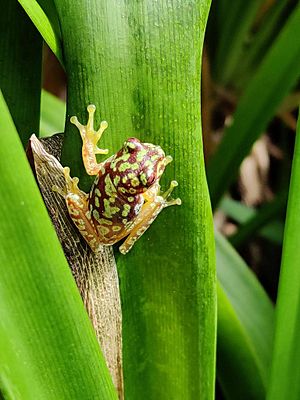Copan brook frog facts for kids
Quick facts for kids Copan brook frog |
|
|---|---|
 |
|
| Conservation status | |
| Scientific classification | |
| Synonyms | |
|
Hyla soralia Wilson and McCranie, 1985 |
The Copan brook frog (Duellmanohyla soralia) is a special type of frog. It belongs to the Hylidae family, also known as tree frogs. You can find this frog in the mountains of northeastern Guatemala and northwestern Honduras. It lives in places like the Sierra del Merendón and Sierra de Omoa mountain ranges. This frog has very unique colors and patterns. Its scientific name, soralia, comes from how its markings look like certain lichens, which are tiny plant-like growths.
What Does It Look Like?
The Copan brook frog is a small frog. Male frogs grow to about 32 millimeters (about 1.25 inches) long. Female frogs are a bit bigger, reaching about 38 millimeters (about 1.5 inches). This frog has a very blunt snout. Its eyes stick out and have bright red irises.
The male frog has a special pouch under its throat called a vocal sac. This sac helps it make calls. The frog's back is brown with clear patterns. These patterns include green, olive, and black spots or blotches. These spots often have light edges. The frog's belly is yellow. Its front legs have white streaks on the outside.
Where Does It Live?
This tree frog lives only in certain mountain areas. You can find it in northwest Honduras and northeast Guatemala. It likes to live in moist tropical forests. It also lives in cloud forests. These are forests high up in the mountains, often covered in clouds. It lives at heights of up to 1,570 meters (about 5,150 feet) above sea level.
How It Lives
The Copan brook frog is a nocturnal animal. This means it is active mostly at night. You will usually find it in or near streams. It likes to sit on low plants or on rocks next to the water.
These frogs breed during the months of May, June, and July. Their tadpoles are a pale yellowish-green color. They have shiny green spots and red eyes. The tadpoles live in shallow pools of water.
Why It's Endangered
The Duellmanohyla soralia is listed as an Endangered species. This means its numbers are getting very low. The IUCN Red List of Threatened Species tracks its status.
One big reason for the decline is a disease called chytridiomycosis. This disease is caused by a fungus called Batrachochytrium dendrobatidis. In Cusuco National Park, where the frogs' home is protected, this fungus is a main problem.
In other areas, the frog faces more threats. Forests are being cut down for farms, which destroys their homes. Water pollution also harms these frogs.
See also
 In Spanish: Duellmanohyla soralia para niños
In Spanish: Duellmanohyla soralia para niños


